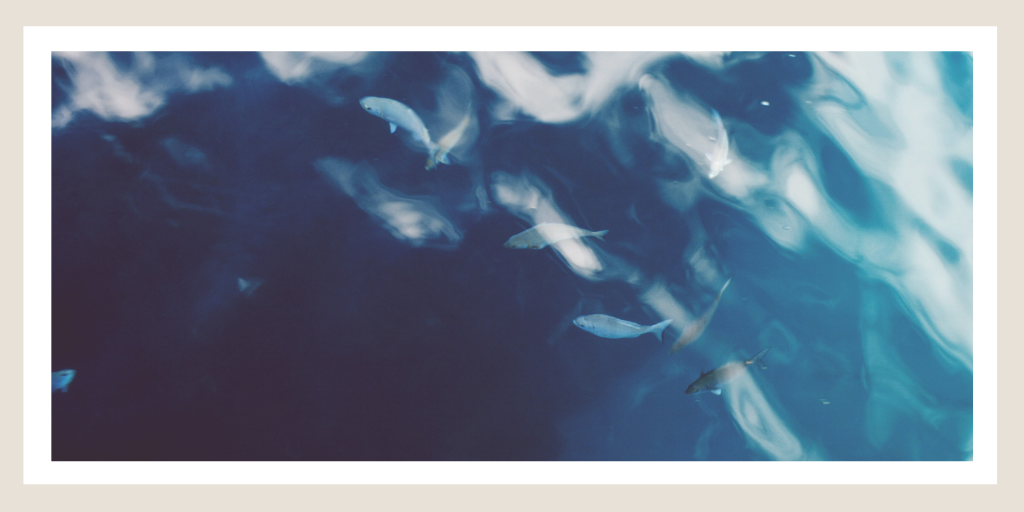Writing Underwater

Writing can be a great friend in the face of loss. It can capture a fleeting moment, thought or sensation, or the meaning of an object, and pin it down on paper before it escapes the grasp of memory.
But sometimes the opposite is true, and the act of writing seems to overwrite or undercut the very essence of the thing you were trying to catch. You read back what you’ve written and that ungraspable spark of life you hoped to capture is nowhere to be found. When this happens in my writing, I’m reminded of this sparkling passage from Virginia Woolf’s book A Room of One’s Own:
Thought—to call it by a prouder name than it deserved—had let its line down into the stream. It swayed, minute after minute, hither and thither among the reflections and the weeds, letting the water lift it and sink it, until—you know the little tug—the sudden conglomeration of an idea at the end of one’s line: and then the cautious hauling of it in, and the careful laying of it out?
… sure enough, when she does lay her thought out on the riverbank, like that fleeting moment or meaning or sensation I try to lay out on the page, it seems curiously small and insignificant—like a fish out of water. The scraps of writing that make up Gertrude Stein’s Tender Buttons read, to me, like fish darting underwater, still full of life. When I read them, I feel as though I have been plunged underwater too, and must learn to hold my breath long enough to glimpse whatever thing it is they briefly brush against. Stein’s writing is difficult to read because she is effortfully resisting using language as a hook to capture its prey and haul it up onto the bank. Watch how her words brush against these clothes, for instance:
A PETTICOAT.
A light white, a disgrace, an ink spot, a rosy charm.
A SHAWL. A shawl is a hat and hurt and a red ballon and an under coat and a sizer a sizer of talks.
A shawl is a wedding, a piece of wax a little build. A shawl.
Pick a ticket, pick it in strange steps and with hollows. There is hollow hollow belt, a belt is a shawl.
A plate that has a little bobble, all of them, any so.
Please a round it is ticket.
It was a mistake to state that a laugh and a lip and a laid climb and a depot and a cultivator and little choosing is a point it.
A LONG DRESS.
What is the current that makes machinery, that makes it crackle, what is the current that presents a long line and a necessary waist. What is this current.
What is the wind, what is it.
Where is the serene length, it is there and a dark place is not a dark place, only a white and red are black, only a yellow and green are blue, a pink is scarlet, a bow is every color. A line distinguishes it. A line just distinguishes it.
In this month's prompt we ask how could your writing brush against something you hold dear, and resist hauling it out of the water to pin onto the page?
Here is a method you could try:
1. Choose a special object, sensation, or moment, and begin by writing a list of a mixture of words, sentence fragments, and full sentences:
- What other things does your object resemble? Or, what other moments or sensations does it bring to mind?
- Where does your object belong? Where is it at home?
- What events, actions or gestures do you associate with it?
- What shape is your object? What shape is it nearly? What shape is it not? And its colours, textures and scents?
- What are its opposites?
2. Now, how is your object getting on? Is it still breathing? Still swimming? Might your words be drawing too close? Try to try to pull back slightly, and let your description unspool. Add to your list some associations that lie a little further away:
- Those other things, moments, sensations, actions or gestures you have already listed: what do they bring to mind? What feelings, what times of your life or of history, what further memories do they evoke in you?
- Do you feel at home among these associations? Do they unsettle you?
- If you speak more than one language, which are in play here?
- What tone of voice do they deserve? Are they observations? Facts? Wishes?
3. Next, think about structure. Stein’s phrases often evade familiar grammatical structures. Sometimes they seem to evade sense altogether. Is your grammar tightly wrapped around your object? Could you loosen it a little, to give it room to breathe, room to dart and swim through the dark waters of imagination almost unobserved? For your object, and your experience of it, where is the balance between sense and life?
4. Finally, which associations are most immediate to your object, and which are further away? This might help to order your writing. Perhaps your writing can read like a bloom of associations, dense at the beginning then drifting apart. Perhaps it is richest at the centre, with its edges getting hazy. Perhaps it builds up, loosely at first, then tighter and tighter. Perhaps in the end, you do capture your object after all. With regret? With relish? With relief?
We hope that you might find some inspiration in this week's writing prompt but as always if you would like to write something else about your life - a diary entry, poem, your reflections on something else about your life at the moment - we'd be delighted to read whatever you would like to send. To go directly to the submission page and send us your writing, click here.
Guest writer

Dr Tamarin Norwood
This month's guest prompt was created by writer, artist and grief researcher Tamarin Norwood. Tamarin is a postdoctoral research fellow at the Drawing Research Group, Loughborough University, where she is writing a book on metaphor and neonatal loss. She is also a visiting early career research fellow at the Centre for Death and Society, University of Bath, and researcher at the Oxford Centre for Life Writing, University of Oxford where she convenes the Lives in Medicine research network.
She gained her doctorate in Fine Art as a Clarendon scholar at the University of Oxford in 2018. Her scholarly publications focus on representation and loss in drawing; her related prose fiction, poetry and artwork have been published and shown widely including with the BBC World Service, Art on the Underground, Wellcome Collection, ICA Philadelphia, MOCCA Toronto and Tate Britain. Her book Mourning Lines comes out this year with Ma Bibliothèque.
If you would like to hear more about Tamarin's current project, she features in the Oxford Centre for Life-Writing's podcast series, Biography and Beyond. She speaks about the book she is writing about her son, Gabriel, who died shortly after his birth. The episode is called: Writing a very brief life.



